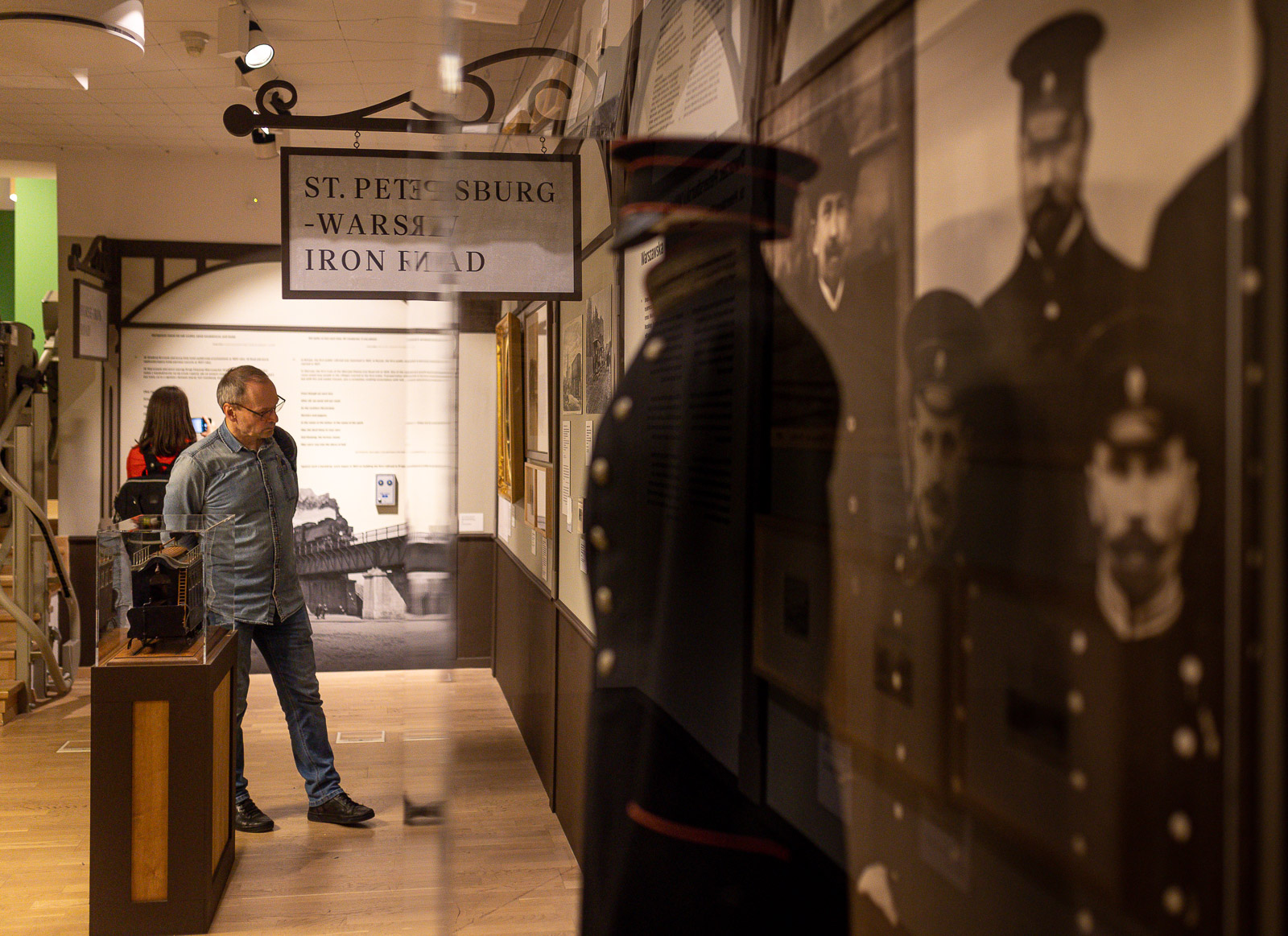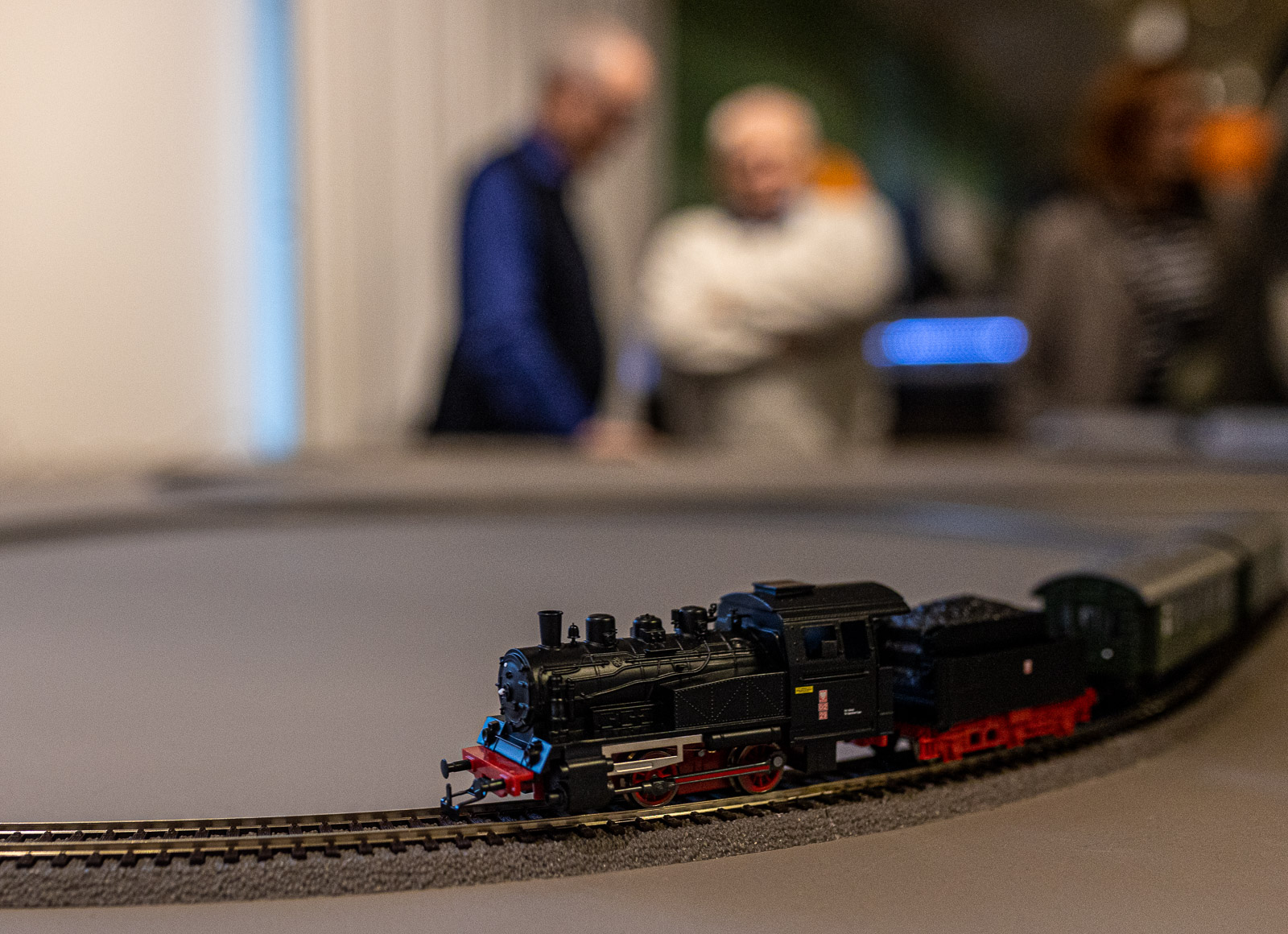EXHIBITIONS
27 April - 15 October 2023
regular 10PLN / reduced 8PLN
Railroad to Praga

Railway was a modern invention that changed Europe. In the second half of the 19th century, it played a key role in the development of right-bank Warsaw. Thanks to the pro-environmental policy of the European Union, railway’s role will yet again become vital in the coming years.
The Railroad to Praga exhibition tells the story of railway stations and railway lines, of railwaymen and passengers, and of the district of Praga which expanded along its railway lines.
FIRST TRAINS

The first trains ran at around 50 km/h. They stopped at stations for up to 15 minutes, and also took breaks to refill water and coal. In 1865, a journey from Warsaw to Vilna took 14.5 hours (today, with a transfer, about 9.5h), to St Petersburg—38 hours (today, with a transfer, 22h). In 1901, the narrow-gauge Jabłonowska Railway ran at 13 km/h within the city, and up to 21.5 km/h beyond the city limits. The slowest was the journey by the Nadwiślańska Railway across the Vistula River. Rotating train traffic put passengers’ patience to the test.
Launching the long-distance iron roads connected Warsaw with the East—with St Petersburg, Terespol and Vilna. It also turned Warsaw’s Praga into an important railway junction. Cheaper import and export of goods attracted industry to the district. The newly established narrow-gauge railways—the Marecka and Jabłonowska railways—transported new Varsovians and facilitated access to the summer resorts of Otwock and Świder. They also transported bricks for the construction of houses in Praga.
Today, railroad transport is making a comeback as an ecological alternative to airplanes and cars. The most recent plans for the city development focus precisely on further developing railroad transport.
HISTORY OF THE RAILWAY ON RIGHT-BANK WARSAW
The Railroad to Praga exhibition takes a closer look at the history of Warsaw’s right bank railway since 1862—from the opening of the first railway line here, until 1974 when the last narrow-gauge railway to Marki left the station. It tells the story of the long-distance iron roads: St. Petersburg-Warsaw, Terespol-Warsaw, Nadwislańska and Obwodowa railway, and the suburban railways: Jabłonowska and Marecka.
The tale of the old stations and trains, of the ambience of travelling by rail and the prospects of future passengers is based on the collections of the Museum of Warsaw, the Warsaw Railway Museum and the National Museum in Warsaw.
The exposition includes:
- unique portraits,
- drawings and photos,
- documents,
- the Różycki family travel chests,
- atypical tickets—including Horse Railcars,
- an app that allows you to take a tour of railway New Bródno,
- passengers’ recollections,
- recorded accounts of railwaymen, esp. from the period of the Second World War.
Thanks to the exhibition, you will get acquainted with the reality of a rail journey in the past. You will also find out how a railwayman dressed in the 19th century, what an elegant lady packed in her trunks and what an old first-class compartment or a third-class railway station waiting room looked like.
You will see a fin de siècle compartment, models of trains, including an illuminated Pendolino model on loan especially for this exhibition. You will sit in the driver’s seat and see what it is like to ride a train from the perspective of a locomotive.
THE FUTURE OF RAILROAD IN PRAGA
The last section of the exhibition looks into the future. Transport is responsible for more than 30% of carbon dioxide emissions into the atmosphere, rail accounts for only 0.4% of those. The European Union is committed to sustainable mobility. This is why, according to the EU objectives, Europe is to be linked by a high-speed rail network by 2050. A network of high-speed rail links is to make us reduce the use of aeroplanes and cars.
Warsaw’s Praga district is likely to see a boost in the role of Warszawa Wschodnia Railway Station as the most important transfer station on this side of the Vistula. The existing cross-city line connecting the right and left banks of the capital will be extended.

Horizontal photo: Street traffic in Praga, 1945-1946, Military Photographic Agency, National Digital Archive
Main photo: Henryk Poddębski, Praga, route of the cross-city line, 1937, Museum of Warsaw collection
Exhibition photo: Tomasz Kaczor
KOLOFON
Curator: Anna Mizikowska
Exhibition design: Maja Zaleska
Exhibition production: Michał Tański and Anna Mizikowska
Graphic design of the poster and promotional materials: Joanna Bębenek, based on the photo by Henryk Poddębski Praga, the Route of the Cross-City Line, 1937, Museum of Warsaw collection
Maps: Witold Pietrusiewicz
Woodcut animation: Rembrandtproject.pl
Graphic elements in the exposition: Małgorzata Czekajło and Rafał Rosiński
Text editing: Urszula Drabińska
Production of set design elements: CERBER-SCENOGRAFIA Arkadiusz Siporski
Audio selection and editing (oral history): Anna Mizikowska
Voiceover: Wojciech Masacz
Multimedia: Piotr Szatyłowicz
”Railroad Bródno” app: Bartosz Wieczorek
Blogs: Dariusz Sieczkowski, Mark Smith
Recordings from the driver’s cab: Krzysztof Waszkiewicz
Conservation: Beata Galperyn-Kołodziejska, Katarzyna Lesiakowska-Tofil, Julia Kłosińska, Janusz Mróz, Piotr Kaczkiełło, Piotr Popławski, Igor Nowak, Robert Kołodziejski
Production: Ksenia Góreczna, Katarzyna Radecka, Anna Stelmaszczyk, Renata Szlifirska, Tomasz Lewandowski, Artur Miniewicz, Michał Bogumił, Piotr Lipiński, Paweł Grochowalski, Krzysztof Hernik, Leszek Sokołowski, Mariusz Wawrzyniak, Dariusz Sałański, Adam Rogowski, Krzysztof Świerczewski, Mariusz Stawski
Coordination of digitization: Mikołaj Kalina
External loans: Janusz Kurczak
Internal loans: Aleksandra Lis, Małgorzata Oliwińska, Dorota Parszewska, Joanna Rykiel, Zuzanna Sieroszewska-Rolewicz, Filip Żelewski
Accessibility: Katarzyna Szafrańska
Accompanying events: Ewelina Bartosik
Scripts for museum lessons: Małgorzata Czekajło, Aleksandra Karkowska-Rogińska, Natalia Morawska
Public procurement and legal supervision: Małgorzata Gońda, Monika Góra
Communication and marketing: Joanna Andruszko, Matylda Dobrowolska, Agata Fijałkowska, Agata Fronczyk, Julia Golachowska, Daniel Karwowski, Aleksandra Koszalska, Anna Ładna, Milena Paszkowska, Jowita Purzycka, Milena Soporowska, Filip Wielechowski-Olszak
Cooperation in research at the Warsaw Railway Museum: Hubert Bojarski and Piotr Kałużyński
Cooperation in research at the National Museum in Warsaw: Tomasz Zborowski, Kornelia Drozdek-Lin, Lan Tyszka-Drozdowska
Cooperation in research at the Museum of Warsaw: Anna Topolska, Agnieszka Dąbrowska, Rafał Radziwonka, Monika Siwińska, Paweł Weszpiński, Aleksandra Sołtan, Katarzyna Kuzko-Zwierz, Krzysztof Filipek
The following collections were included in the exposition: Museum of Warsaw, National Museum in Warsaw, Warsaw Railway Museum, Polona, Warsaw Rising Museum, Gallica, Polish Press Agency, National Digital Archives, Digital Library of Mazovia, Alstom Polska, PKP Intercity, Archive of the Polish Radio in Warsaw, Polish Television S.A., Warsaw Documentary Film Studio, University Library in Warsaw







